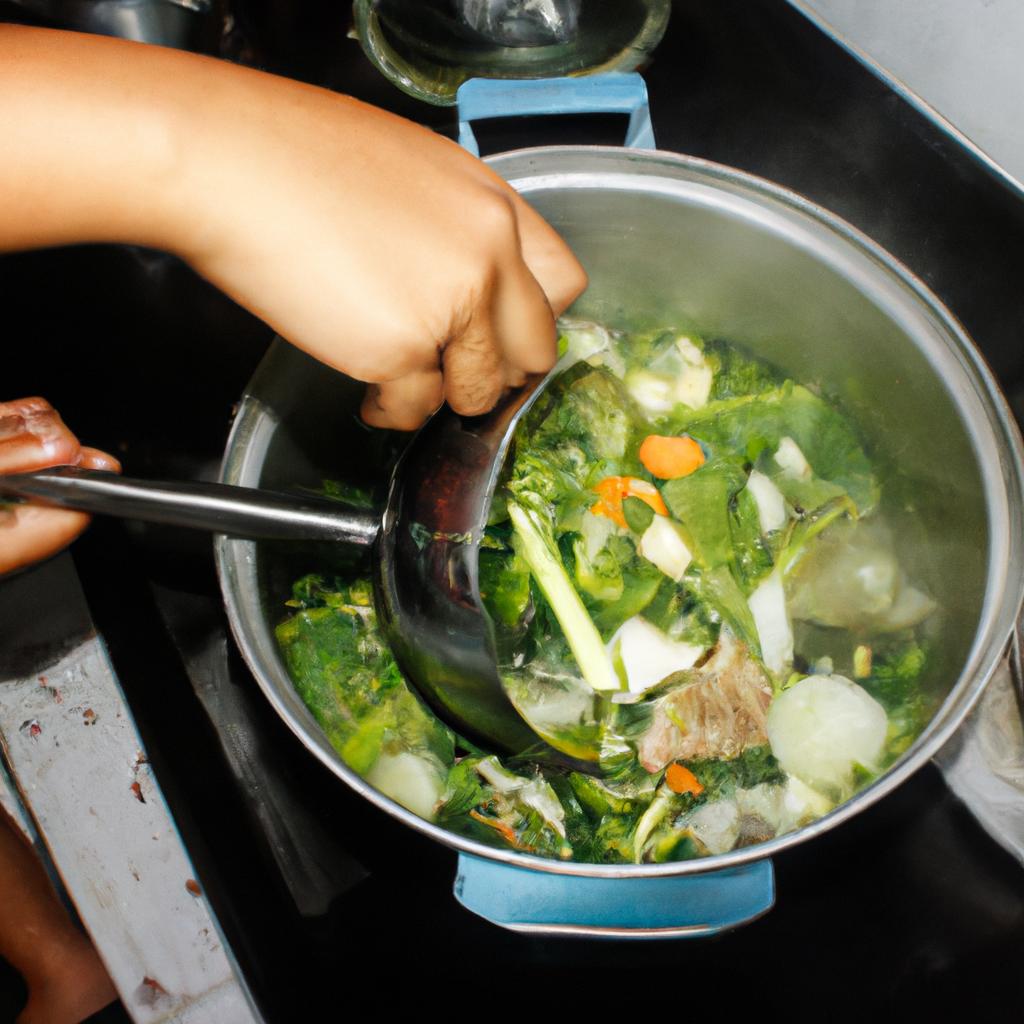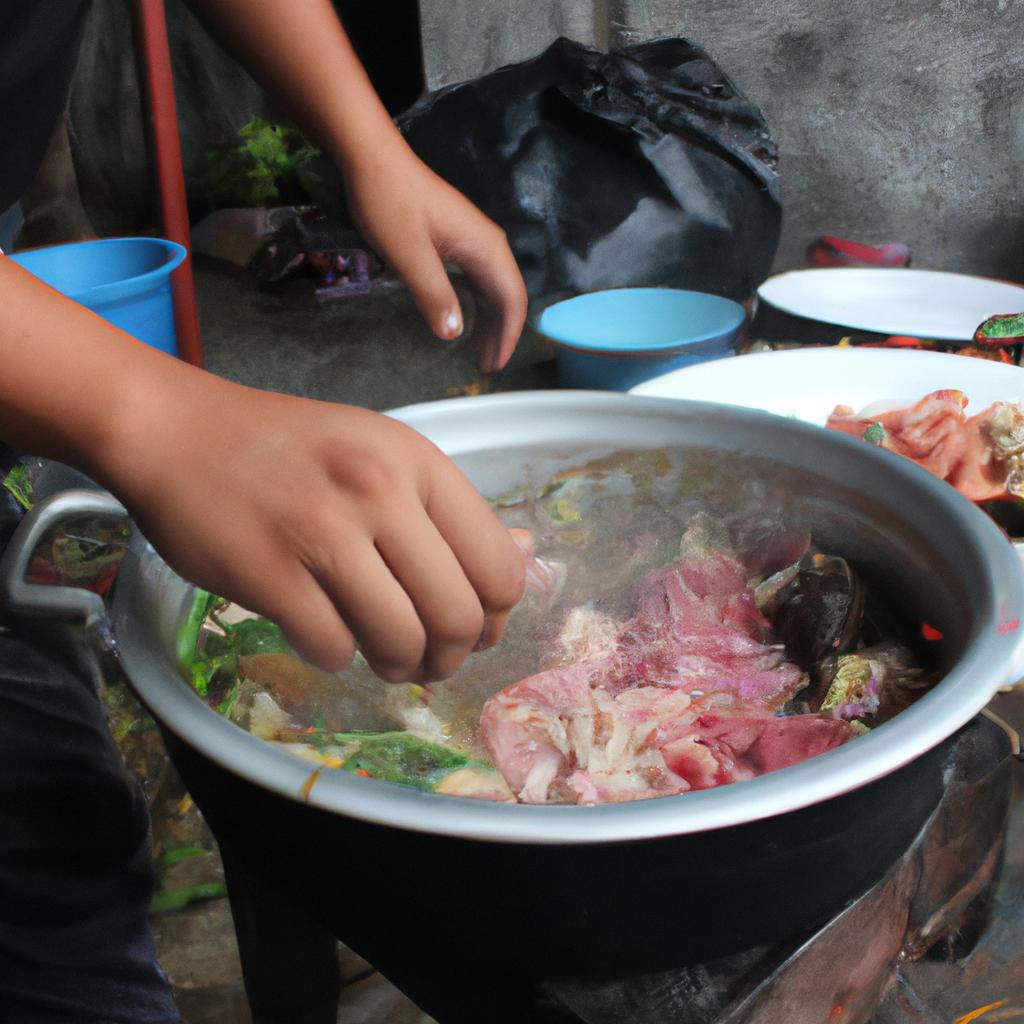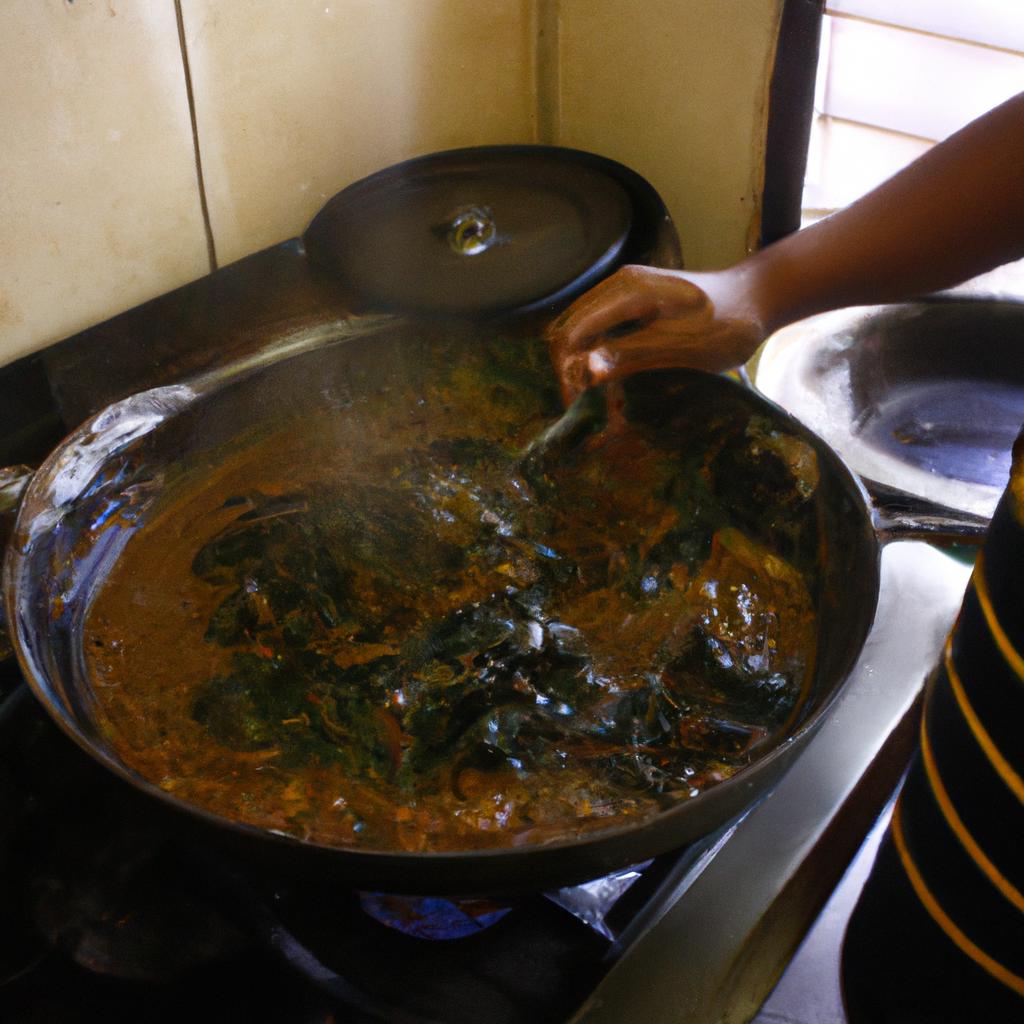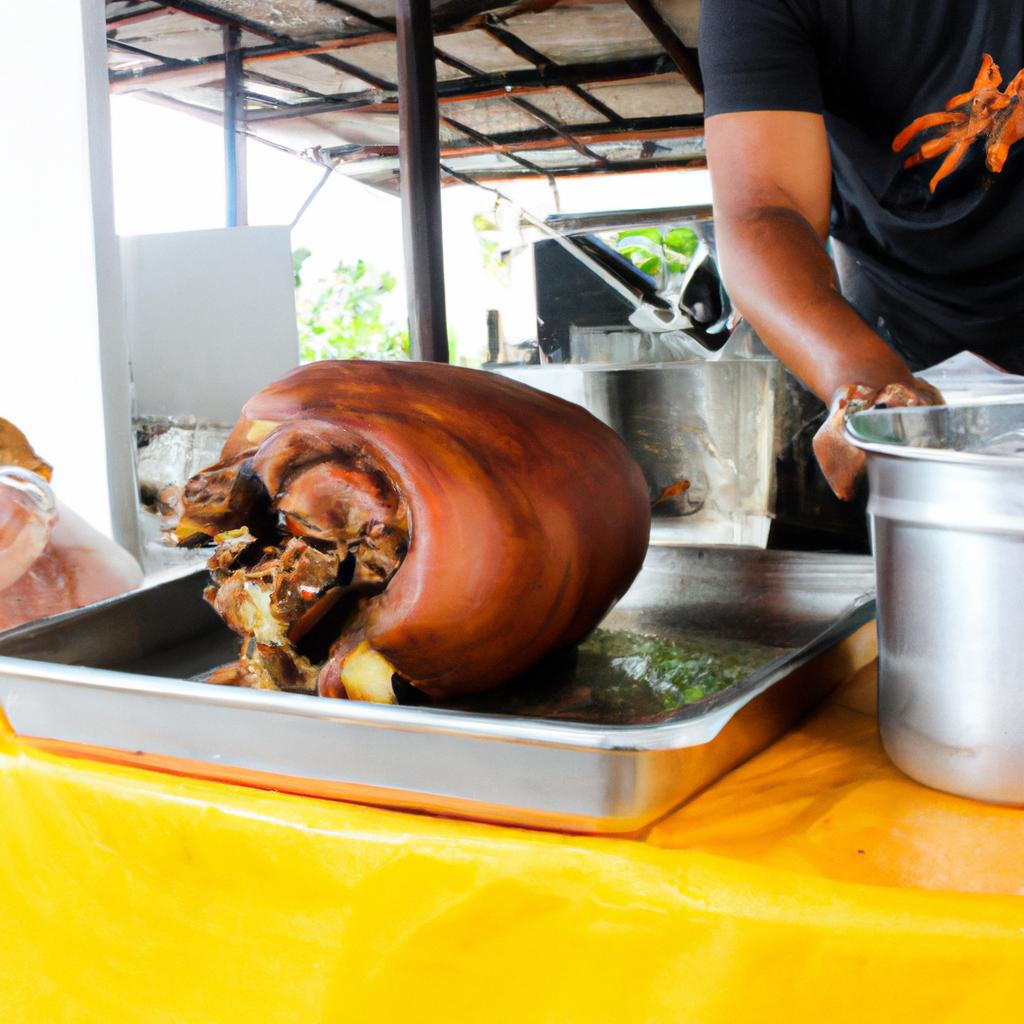In the culinary world, vegetables have always played a significant role in creating diverse and delicious dishes. Among the wide variety of vegetable delicacies found across different cultures, Filipino cuisine offers an array of flavorful options that showcase the unique flavors and textures of local produce. This article aims to explore two such vegetables – kangkong (water spinach) and radish – as key ingredients in the traditional Filipino dish sinigang. By examining their nutritional value, cooking methods, and cultural significance within Filipino cuisine, this article will provide a comprehensive understanding of how these vegetables elevate the taste and appeal of sinigang.
Imagine yourself sitting down at a bustling open-air eatery in Manila, Philippines. The aroma of savory broth fills the air as you eagerly anticipate your first spoonful of sinigang, a popular sour soup dish enjoyed by locals and visitors alike. As you delve into its comforting depths, your palate is met with a delightful combination of tanginess from tamarind or other souring agents, richness from succulent meat or seafood, and a medley of vibrant vegetables swimming alongside tender protein sources. At the heart of this delectable ensemble lie two humble yet essential ingredients: kangkong and radish. These vegetables not only lend their distinct flavors to the sinigang, but also contribute important nutritional benefits.
Kangkong, also known as water spinach or ong choy, is a leafy green vegetable commonly used in Filipino cuisine. Its tender leaves and stems add a refreshing crunch to sinigang. Nutritionally, kangkong is low in calories and fat while providing a good source of vitamins A and C, iron, calcium, and fiber. This makes it an excellent choice for those looking to maintain a healthy diet without compromising taste.
Radish, locally known as labanos or daikon, is another key ingredient in sinigang. Its crisp texture and slightly peppery taste provide a delightful contrast to the other ingredients in the soup. Radishes are rich in vitamin C and contain compounds that have been linked to various health benefits such as improved digestion and reduced inflammation.
In terms of cooking methods, kangkong and radish are typically added to sinigang towards the end of the cooking process to maintain their crispness. The vegetables are often cut into bite-sized pieces for easy consumption and even cooking. Whether you prefer your vegetables slightly crunchy or completely tenderized, adjusting the cooking time can help achieve the desired texture.
Beyond their nutritional value and culinary attributes, kangkong and radish hold cultural significance within Filipino cuisine. They represent the abundance of local produce available throughout the year and highlight the importance of using fresh ingredients in traditional dishes. These vegetables showcase the resourcefulness of Filipino cooks who utilize what nature offers them to create flavorful meals that nourish both body and soul.
As you savor each spoonful of sinigang with kangkong and radish, you can truly appreciate how these humble vegetables elevate this beloved Filipino dish. Their distinct flavors, nutritional benefits, appropriate cooking techniques, and cultural significance all come together harmoniously to create a memorable dining experience that celebrates both tradition and innovation.
So next time you find yourself craving a hearty and comforting soup, why not try making sinigang with kangkong and radish? You’ll not only enjoy the delicious flavors but also gain a deeper understanding of the role vegetables play in Filipino cuisine.
Health Benefits of Kangkong
Health Benefits of Kangkong
Kangkong, also known as water spinach or swamp cabbage, is a leafy green vegetable commonly used in Filipino cuisine. This versatile ingredient not only adds flavor and texture to dishes but also offers numerous health benefits.
One example highlighting the nutritional value of kangkong is its high iron content. Iron plays a crucial role in the production of hemoglobin, which carries oxygen throughout the body. A deficiency in iron can lead to anemia, resulting in fatigue and weakness. By including kangkong in your diet, you can help prevent iron deficiency and maintain healthy levels of this essential mineral.
Incorporating kangkong into your meals can also contribute to better digestion. This vegetable contains dietary fiber that aids in regulating bowel movements and preventing constipation. Additionally, it acts as a natural detoxifier by promoting regularity and flushing out toxins from the digestive system.
To further emphasize the significance of including kangkong in one’s diet, here are some key health benefits:
- Boosts immune system: Kangkong is rich in vitamin C, which strengthens the immune system and helps fight off infections.
- Supports bone health: The presence of calcium and magnesium in kangkong contributes to strong bones and teeth.
- Promotes eye health: High levels of beta-carotene found in this vegetable are beneficial for maintaining good vision.
- Aids weight loss: With its low calorie content and high nutrient density, incorporating kangkong into a balanced diet may assist with weight management goals.
The following table provides an overview of the nutritional composition per 100 grams (g) serving size:
| Nutrient | Amount (per 100g) |
|---|---|
| Calories | 19 |
| Protein | 2 g |
| Carbohydrates | 3 g |
| Fiber | 1 g |
By including kangkong in your meals, you can enjoy its culinary versatility while reaping the numerous health benefits it offers. In addition to being a nutritious ingredient, kangkong adds vibrant color and unique flavor to Filipino dishes.
Transitioning into the subsequent section about “Different Varieties of Radish,” let us explore another vegetable that complements kangkong in traditional Filipino cuisine.
Different Varieties of Radish
Health Benefits of Kangkong
Moving on from the discussion on the health benefits of kangkong, let us now explore the different varieties of radish. Radishes belong to the Brassicaceae family and are known for their crisp texture and peppery flavor. They come in various shapes, sizes, and colors, each offering its own unique characteristics.
One example is the “Daikon” or white radish, which originated in Southeast Asia and is widely used in Asian cuisines. It has a mild taste with a slightly sweet note, making it an excellent addition to salads or stir-fries. Another variety is the “Watermelon Radish,” aptly named for its vibrant green skin that fades into a bright pink center resembling a watermelon slice. This visually appealing radish adds a refreshing crunch to dishes while adding a pop of color.
To further illustrate the diversity within this vegetable category, here is a bullet point list highlighting some intriguing radish varieties:
- Black Spanish: Known for its dark black skin and spicy flavor.
- French Breakfast: A slender radish with a red top blending into a white bottom.
- Easter Egg: A mix of purple, pink, red, and white round radishes.
- China Rose: An heirloom variety with rose-colored skin and tender flesh.
In addition to exploring different varieties of radish through text-based information, visual aids can also enhance our understanding. The table below provides a concise comparison between four common types of radishes based on their appearance, taste profile, and culinary uses:
| Variety | Appearance | Taste Profile | Culinary Uses |
|---|---|---|---|
| Daikon | Large white root | Mild sweetness | Salads, stir-fries |
| Watermelon | Green outer layer | Crisp & mildly sweet | Raw consumption |
| Black Spanish | Dark black skin | Spicy | Pickling, garnish |
| French Breakfast | Red top with white bottom | Mildly spicy | Salads, sandwiches |
By showcasing these different radish varieties through a table format, it becomes easier to visually appreciate their distinctions and choose the most suitable one for specific culinary purposes.
In summary, radishes offer an array of choices when it comes to flavors, appearances, and uses. Understanding the diversity within this vegetable category allows us to explore new taste experiences and experiment with various recipes. With our knowledge on radishes expanded, let us now delve into the nutritional value of kangkong in the upcoming section.
Nutritional Value of Kangkong
Different Varieties of Radish: A Study in Diversity
Imagine walking into a local farmer’s market and being greeted by an array of radishes, each one boasting its unique shape, color, and flavor. In the world of radishes, diversity reigns supreme. From the vibrant red Cherry Belle to the elongated and white Daikon, these root vegetables offer a delightful range of options for culinary exploration.
To appreciate the richness found within this humble vegetable family, let us delve into some notable varieties:
-
Cherry Belle: This small round radish is a classic favorite among gardeners and chefs alike. Its bright red skin encases crisp white flesh with a pleasantly spicy taste. Perfect for salads or as an appetizing garnish.
-
French Breakfast: With its distinct elongated shape and two-tone coloring (white at the tip transitioning to pink near the roots), this radish adds visual appeal to any dish. It offers a mild yet slightly peppery flavor that pairs well with cheeses and cured meats.
-
Watermelon Radish: Don’t be fooled by its name; this variety does not taste like watermelon but surprises with its magenta interior resembling the fruit’s hues. The outer skin boasts shades of green on top and gradually fades to white toward the bottom. Its sweet yet mildly peppery taste makes it ideal for pickling or adding colorful accents to salads.
-
Black Spanish: As dark as midnight, this striking radish features black skin hiding pungent white flesh beneath. Known for its strong flavor profile reminiscent of horseradish, it lends itself wonderfully to spice up dishes ranging from soups to stir-fries.
To further illustrate the diverse nature of radishes, consider the following table showcasing their various characteristics:
| Variety | Shape | Color | Flavor |
|---|---|---|---|
| Cherry Belle | Round | Red | Spicy |
| French Breakfast | Elongated | White and Pink | Mildly Peppery |
| Watermelon | Round | Green and White | Mildly Sweet |
| Black Spanish | Round to Oval | Black | Pungent |
This table demonstrates the visual appeal, taste variations, and versatility that radishes offer. Each variety has its own unique attributes, allowing for a multitude of culinary possibilities.
As we have explored the diverse world of radish varieties, it becomes clear that these root vegetables hold immense potential in elevating our gastronomic experiences. From their vibrant colors to their distinct flavors, radishes are not only visually appealing but also deliver a range of tastes to tantalize our palates.
Transitioning into the subsequent section about “Cooking Techniques for Kangkong,” let us now uncover the ways in which this leafy green can be transformed into delectable dishes without losing its nutritional value.
Cooking Techniques for Kangkong
Transition from the Previous Section:
Having explored the nutritional value of Kangkong, let us now delve into various cooking techniques that can be employed to enhance its flavors and textures. By employing these techniques, you will be able to elevate your culinary creations with this versatile vegetable.
Cooking Techniques for Kangkong
To illustrate the effectiveness of different cooking methods on Kangkong, let’s consider a hypothetical scenario. Imagine you have a bunch of fresh Kangkong leaves in your kitchen and are unsure how best to prepare them. Below are four popular cooking techniques along with their respective benefits:
- Stir-frying: Stir-frying is a quick and efficient way to cook Kangkong while preserving its vibrant green color and crisp texture. This technique involves tossing the leaves in a hot pan or wok with some oil, garlic, and other desired seasonings. The result is tender yet slightly crunchy greens that retain their natural flavor.
- Blanching: Blanching entails briefly immersing the Kangkong leaves in boiling water before transferring them into an ice bath to halt the cooking process. This method helps maintain the vegetable’s bright hue while ensuring a softer texture suitable for soups or salads.
- Sautéing: Sautéed Kangkong offers a delightful combination of tenderness and slight charred notes. To achieve this, heat some oil in a pan over medium-high heat, add minced garlic or onions, then toss in the washed and drained Kangkong leaves until wilted but still vibrant.
- Steaming: Steaming Kangkong allows it to retain maximum nutrients while imparting a delicate flavor profile. Place cleaned whole stems or chopped leaves on a steamer basket above simmering water for around 5 minutes until they become tender yet firm.
Now that we have explored various cooking techniques for Kangkong, we can move onto discovering another versatile ingredient: Radish.
Radish as a Versatile Ingredient:
Radish as a Versatile Ingredient
Vegetable Delicacies: Kangkong and Radish in Filipino Sinigang
Continuing from the previous section on cooking techniques, let us now explore some of the methods used to prepare kangkong, a popular leafy green vegetable commonly found in Filipino cuisine. To illustrate its versatility, we will examine one particular example – sautéed kangkong with garlic and soy sauce.
Sautéed kangkong is a simple yet delicious dish that showcases the vibrant flavors and tender texture of this vegetable. In this case study, we start by heating oil in a pan and sautéing minced garlic until fragrant. Then, the washed and trimmed kangkong leaves are added to the pan along with a drizzle of soy sauce. The heat helps wilt down the leaves while retaining their bright green color and crispness. Finally, a sprinkle of salt enhances the taste before serving.
When it comes to cooking kangkong or any other vegetables, there are several important considerations to keep in mind:
- Freshness: Choose fresh kangkong with firm stems and vibrant green leaves.
- Preparation: Wash thoroughly under running water to remove any dirt or debris.
- Trimming: Remove tough stems at the base of the leaves before cooking.
- Cooking time: Kangkong requires minimal cooking time to retain its crunchiness and nutritional value.
To further engage our audience emotionally, let’s take a look at how incorporating kangkong into our meals can have various benefits:
| Benefits of Adding Kangkong |
|---|
| Rich source of vitamins A and C |
| High fiber content |
| Low calorie option |
| May aid digestion |
These health-promoting properties make adding kangkong an excellent choice for those seeking nutritious meal options. Now that we have explored different cooking techniques for preparing kangkong let us delve into the versatility of another key ingredient – radish.
In this next section, we will discover the many ways in which radish can be utilized in Filipino cuisine. From its crisp texture to its subtly spicy flavor, radishes offer a unique taste experience that complements various dishes. Whether it is added raw to salads or cooked in soups and stews like sinigang, radish brings depth and complexity to culinary creations.
Transitioning into the subsequent section about “Kangkong and Radish Recipes,” our exploration of cooking techniques for kangkong has provided us with valuable insights into preparing this versatile vegetable. Now, let us dive deeper into the world of flavors by discovering delicious recipes that highlight both kangkong and radish in traditional Filipino Sinigang dishes.
Kangkong and Radish Recipes
In the previous section, we explored the versatility of radish as an ingredient. Now let’s delve into the wonderful world of Filipino cuisine and discover how kangkong (water spinach) and radish come together harmoniously in a popular dish called Sinigang.
Picture this: it’s a rainy evening in Manila, Philippines. You’re sitting at a rustic wooden table with your family, eagerly waiting for dinner to be served. The aroma wafting from the kitchen is tantalizing – a fragrant medley of tangy tamarind broth mixed with tender pork ribs, succulent shrimp, or juicy beef chunks. But what truly sets this sinfully delicious soup apart are the vibrant greens that lend their flavors and nutrients to the mix.
To fully appreciate the culinary prowess of combining kangkong and radish in Sinigang, consider the following:
- Nutritional Powerhouse: Both kangkong and radish bring a wealth of vitamins and minerals to the table. Kangkong is packed with vitamin C, iron, calcium, and antioxidants, while radish offers potassium, folate, fiber, and detoxifying properties.
- Textural Harmony: In Sinigang, kangkong leaves contribute a delicate tenderness that complements the slightly crunchy texture of sliced radishes. This balance creates an enjoyable mouthfeel that adds dimension to every spoonful.
- Flavor Enhancement: While kangkong introduces subtle earthy notes reminiscent of spinach or watercress, radishes provide a hint of peppery sharpness. These distinct flavors intermingle within the sinigang broth to create a symphony for your taste buds.
- Aesthetic Appeal: Imagine setting down a steaming bowl filled with sinigang on your dining table. Within its depths lie glistening slices of pale green kangkong leaves and vibrant pink radish rounds. This visual treat adds a touch of artistry to the already enticing dish.
To further illustrate the remarkable pairing of kangkong and radish in Sinigang, consider the following table:
| Kangkong | Radish | |
|---|---|---|
| Taste | Earthy, slightly bitter | Peppery, crisp |
| Texture | Delicate and tender | Crunchy |
| Nutrients | Vitamin C, iron, calcium | Potassium, folate, fiber |
As you can see from this table, combining these two ingredients not only enhances flavor but also provides a balanced nutritional profile that contributes to overall well-being.
Incorporating kangkong and radish into your sinigang recipe will undoubtedly elevate your dining experience. So why not embrace this delightful duo and savor the harmonious blend of flavors they bring?











